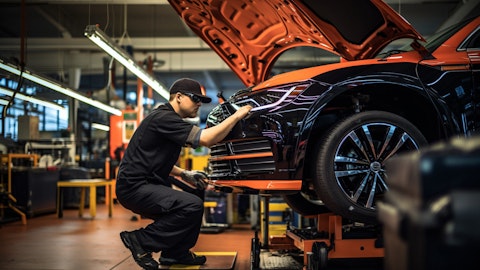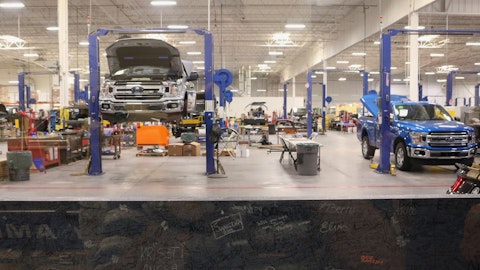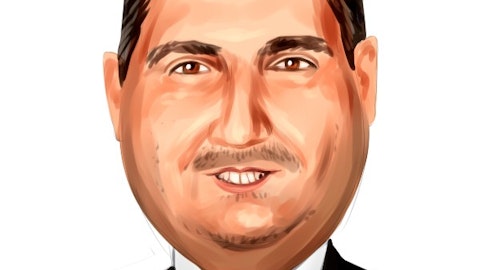Mary Meixelsperger: Yeah. So in terms of the overall same-store sales, we actually see a fair amount of consistency in the first half versus second half. And so I do expect that we’ll still see a little bit stronger amount of the comp coming from ticket versus transactions this year, but it will be certainly more balanced than what we saw in fiscal 2023.
Steven Zaccone: Okay. Great. And then, just the second question I have is, just on capital allocation. So when you’ve completed this authorization, what’s the willingness to continue to buy back stuff? How do you think about that as a priority for your overall cash flow?
Mary Meixelsperger: Yeah. Well, we’ve made a commitment to turn excess capital — return excess capital to shareholders. So as our EBITDA grows and as we manage through our target leverage ratio of that 2.5 to 3.5 times rating agencies adjusted leverage ratio. I expect that we will see continued returns of capital to shareholders overtime. The business — we’ll continue to generate strong free cash flow. And again, with growing EBITDA I don’t expect us to allow the balance sheet to get lazy. And I do think that we should see continued returns of capital over time. I think we will evaluate that subject to market conditions. After we complete the current authorization. And so I think you should expect to hear more about what our plans are with our next earnings call on Q1.
Steven Zaccone: Okay. Great. Thank you so much for detailed answer.
Operator: Thank you. Our next question comes from Simeon Gutman with Morgan Stanley. Please go ahead.
Simeon Gutman: Hi, everyone. Good morning. Mary one of your answers preempted this question I was going to ask surprise surprised on base oils and the gross margin outlook. So you kind of suggested that product costs have already come in. I’m curious how that’s embedded into the guidance? And then if those expectations changed at all as you actually move through the fourth quarter?
Mary Meixelsperger : Yes. Well typically Simeon we take what we know today and reflect that in the guidance. So to the extent that we see base oil increases that ultimately would flow through to lubricant cost increases under our supply agreement that’s not factored in. We’re really factoring in. And the same goes for base oil reductions. If we saw incremental base oil reductions from where we are today that opportunity is not factored in either. We did do some math to try to help you better understand the impact of so if there was a dollar increase in base oils it would take about a 50% increase in price on the company side — I’m sorry, $0.50 increase — excuse me, for a $1 increase in base oil, so it would take about a $0.50 increase in price to be able to cover that cost increase said a little differently about $1 increase in base oil cost would impact unfavorably gross margins by about 50 basis points and that 50 basis points would be made up with about a 50% increase in prices.
Now that’s just on the company side of the business. On the franchise side of the business we passed through base oil costs lubricant costs on a quarterly basis under our contracts with the franchisees.
Simeon Gutman: Okay. And then I’m going to ask a follow-up and then with the second question in it. When you mentioned that the products got better and you mentioned both the waste oil is it that the underlying base oil got better or the waste or both? And then that completely separate question is can you talk about promotional environment? What’s happening is the higher prices that you’re getting in the marketplace they’re sticking but are they being call it funded by promotions? Can you talk about that overall?
Mary Meixelsperger : So our waste oil contracts are tied to base oil indexes. So when we saw modestly — modest improvement in the quarter it was a modest improvement on both ends because they’re kind of integrally tied contractually. Lori, do you want to talk about the promotional?
Lori Flees : Sure, Simeon. We’re actually seeing — we see pockets of discounting happening by competitors, but it hasn’t actually changed our overall approach. And when we look at our retention rate for new-to-file customers that’s customers who’ve never been to VIOC location. We have not seen any difference in retention rate, over last year and we don’t expect to — in the coming year. We actually have initiatives to try to increase retention by just addressing some of the feedback around our process for new customers. In fact, if we look at FY 2023, we’ve been doing a lot of work to optimize our marketing spend and really get more almost personalization approach to discounts that are offered, and our year-over-year discount has come down even in an environment where I think people are concerned about the resiliency of the customer.
We’re just getting smarter around, what discounts are required for which type of customers, based on the channel that we’re acquiring from. But on the promotional side, we’re not seeing any deterioration on the retention of a new to file customer or the active customer base.
Simeon Gutman: Thank you.
Operator: Our next question comes from Kate McShane with Goldman Sachs. Kate, please go ahead. Your line is open
Q – Kate McShane: Hi. Good morning. Thanks for taking our question. I wondered if we could ask first what the average age of vehicles are that are coming to Valvoline? And just given what we’ve seen at the dealerships with affordability headwinds? Are you seeing any change in the age of cars coming in?
Mary Meixelsperger: The average age of vehicles that we see our sweet spot Kate is, really between, right around three years when cars come off of warranty up to about 12 years. So the average age of a vehicle that we see is kind of in the mid eight-year range. And that really — we haven’t seen any significant change in that — in the quarter. So, I would tell you that our consumer is continuing to show, demonstrate their need for this kind of nondiscretionary service and maintaining their vehicles. And we continue to like the spot that we see. We do think there’s opportunities for us to take some more share from dealerships, because our process is very convenient. So, over time will we see that entry spot come down from that kind of three-year point. I think there’s real opportunity for us there, as we continue to market and really drive the point of how convenient our service is.
Lori Flees: Yes. I’ll just add Kate, that the sweet spot or the highest percentage of penetration of the car park is between year six and nine of vehicle life. But that said, the average age of the vehicle this year this past year that came in relative to the year before was 10 months older. So, we are seeing people keep their cars longer. We know that that’s data that’s out in the market and that has actually also been consistent, with our customers’ vehicle age. But the level of penetration is the highest in your six through about 10, and then it continues to expand out as customers keep their cars. I do agree with Mary, we have been expecting the dealers to start to use other preventive maintenance as a way to bring people back in to look for cars.
I think with the automotive strike that they may have held off on that, just given where supply is, but that’s our assumption because we’re not seeing it at this time. We may see pockets of it in a specific market, but we’re not actually seeing those kind of dynamics happening from a customer retention or an acquisation standpoint.




